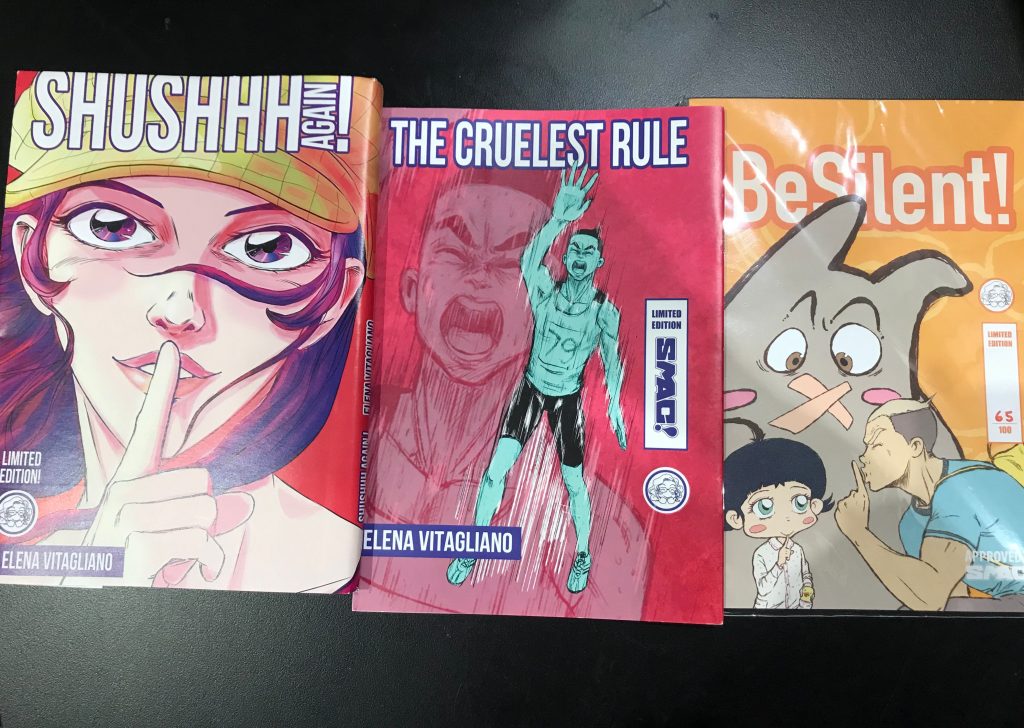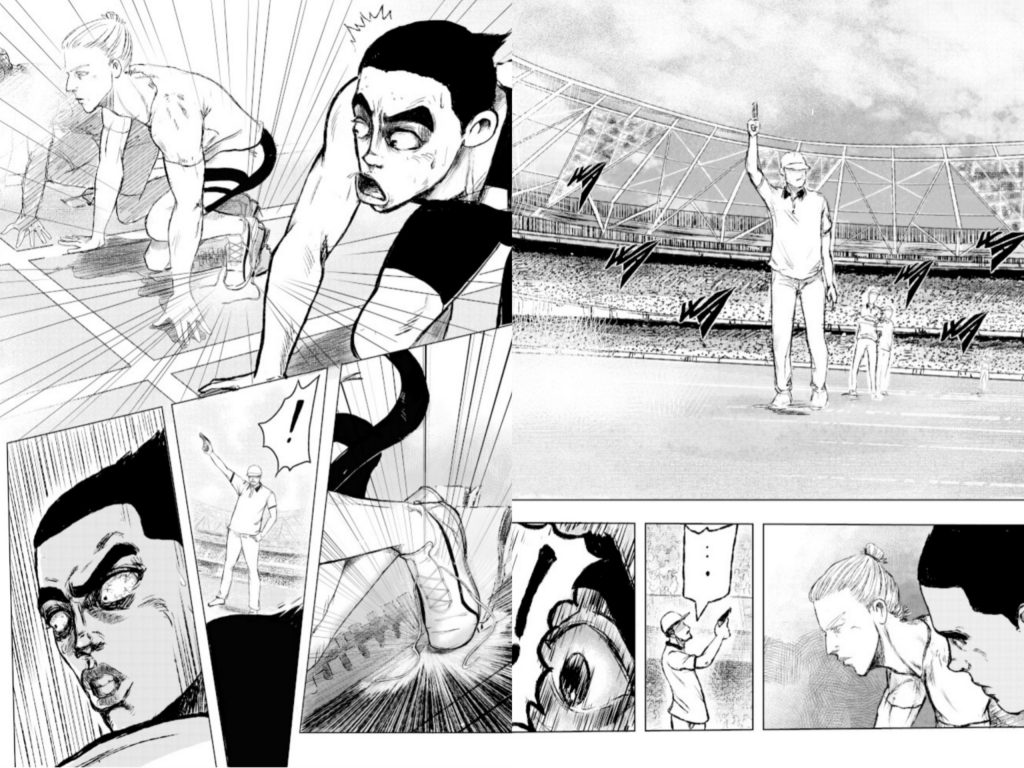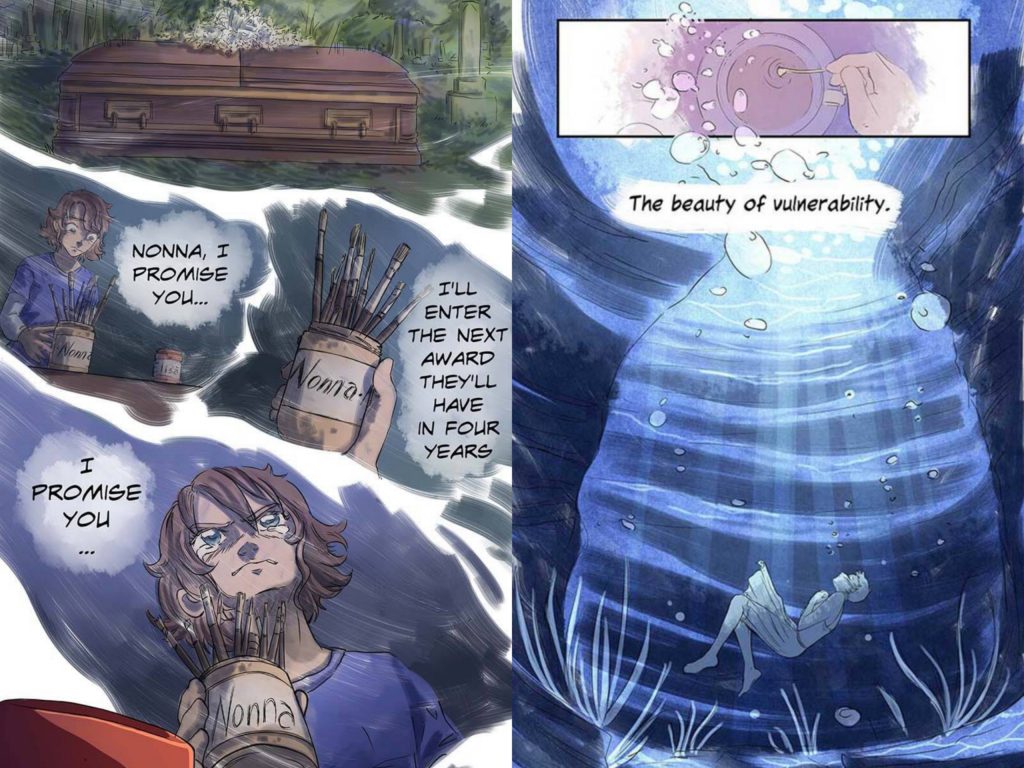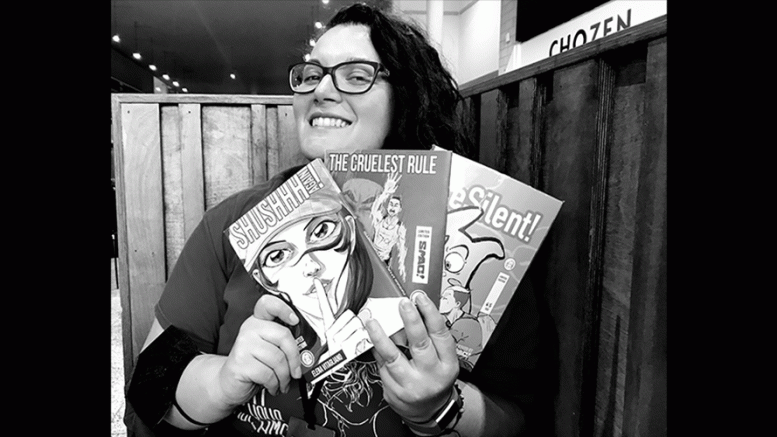Elena Vitagliano is an award-winning Italian comic artist based in London. Her work is related to the analysis of human emotions and the meaning of life. Growing up in Italy, Elena had a steady diet of old anime and manga classics, which greatly impacted her life later on. I met Elena at the Autumn London Comic Con to discuss her outstanding career.
What inspired you to become a mangaka?
“When I was a child, I watched loads of Japanese anime. I didn’t know what it was or where it was made at the time, but I did know that the stories I liked were different. Later on, when I learnt more about anime, I also discovered manga.
I loved drawing even as a child, I created short comics about everyday life and science. Once I drew a whole comic about a character explaining the stars, and my mom, a teacher, asked me if she could use it in her classes.
After getting my first manga, I had to buy so many more. Reading the adventures of these characters makes you think, gives you courage, makes you laugh and keeps you company – sometimes you need that in your life. I wanted to do the same through my work, inspire others, and give back what I have received.”

– Picture by Anna Kamocsai
Is there a big anime and manga culture in Italy?
“In Italy, we watched anime for a long time without realising what it was. It was at the end of the 70s when the first Japanese animation aired on TV in Italy. The interest in manga started in the 90s, even though some manga was already available in the 80s. The big wave of this culture has only been growing since.”
What key events do you think led you to where you are now in your career?
“Definitely winning the Grand Prix Award in the Silent Manga Audition with my manga ‘The Cruelest Rule’ in 2017.
Before that, I won the Manga Jiman Competition in 2011, organised by The Embassy of Japan. I think it was the first step in believing a bit more in myself. I tried drawing manga as a teenager, but until that point, it was just a hobby.
I studied Art and Japanese language in Italy, through which I visited and worked in Japan for a year. Later on, I struggled to find a job in Italy, so I moved to England to become a Graphic Designer. It didn’t really work out, as the company I worked for in London shut down. But I thought, maybe now is the time to focus on manga.
I found out about Manga Jiman, thinking that if I entered and nothing happened, it really meant that I don’t have a talent for the field. It sounds silly now, because failing a competition doesn’t mean someone is not talented, maybe the story just isn’t the right one for it. But in that case, for me, it worked out.
Now when I look back at those pages I created, I’m struck with how much I’ve progressed since, and that I managed to achieve something even with them. It was such a good feeling, especially from a position of no expectations, it really encouraged me.
Following the competition, some companies and individuals started to contact me. It wasn’t all easy, but I saw the difference, people started noticing me.”

Can you tell me more about the Silent Manga Audition and the inspiration behind ‘The Cruelest Rule’?
“I entered that competition seven times before winning, luckily, they had two rounds per year. I looked at the previous winners, learnt from them and kept practicing. It took a bit of time, but it worked.
In 2017, the theme of the competition was ‘Fair Play’. I always liked manga about sports because of the encouragement and enthusiasm. I came across the picture of Usain Bolt, a Jamaican athlete, running a whole competition with his shoelace untied. I was thinking, what would you do if you were an athlete and noticed that your competitor had the same problem, would you say anything? In these competitions, the rules are very strict, if you move, it doesn’t matter for what reason, you get disqualified straight away.
Making a manga without any words was one of my biggest challenges. I would advise everyone who wants to be a mangaka to create one, it really makes you think about how powerful images are and understand how to create a story.”
Tell me about exhibiting and publishing in Japan after the Silent Manga Audition
We did a couple of exhibitions with the winners’ pages, which was very nice. Also, the first three prize winners were invited for a week in Japan. It was great being together with fellow artists, having the same spirit, talking about manga and the obstacles we are facing.
We met legends of Japanese manga, like Tetsuo Hara, the mangaka of the ‘Fist of the North Star’, and Tsukasa Hojo, the creator of ‘City Hunter’. We also received short lessons from them, it was an amazing experience.
COAMIX Inc, the organiser of the Silent Manga Audition, also have a manga magazine called Monthly Comic ZENON, where my manga was featured.
What are you working on nowadays and what are your plans for the future?
Recently, I have been talking with some Japanese editors, trying to see what can come from that. I have also been in contact with a few European publishing houses about a different manga project, but it still needs development.
I am taking part in other competitions in the UK and looking into Japanese ones too. It is not easy, but what is easy?
I have been working with museums, and on events for private companies and individuals. During the Olympics, I drew the portraits of the UK Paralympic swim team, which was an amazing job.
I have started drawing for WEBTOON as well, I created a manga titled ‘A stranger I loved’ during the pandemic.

What advice would you give to aspiring mangakas?
“Don’t just keep dreaming, you need to put the pen on the paper. If you simply think about an idea, it will stay in the air, it won’t take any real shape. It doesn’t matter if you have it all in your mind, having it on paper is completely different.
Find events, organise workshops, enter competitions, it is a source of income and keeps you encouraged. They also give you a deadline, because when you got one you can’t say, “I could do better” , which is not always the best.
An advice I got from Japanese editors – It is better to have bad story from the beginning until the end, rather than have too many beginnings.
Everything is done digitally; you don’t have to move to Japan to become a mangaka. If someone wants to work with you, there are a thousand opportunities to do so.”
Learn more about Elena Vitagliano and her projects!
Words and Images: Anna Kamocsai | Subbing: Andrea Rezman


Be the first to comment on "Elena Vitagliano at the London Comic Con: What is it like to be a manga artist in Europe?"